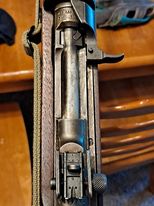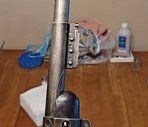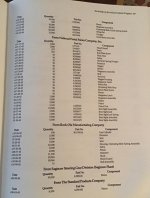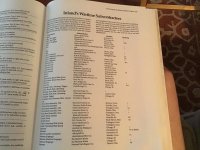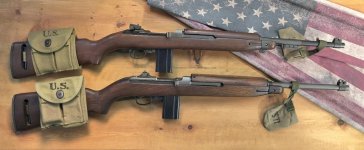Thanks!
Next question: ad an earlier poster pointed out, there are a few parts (rear sight, trigger housing, and stock) that indicate a reasonable. If I was inclined to return this to original condition by purchasing correct parts, where should I begin looking for those, and would it be worth my.time and money to do that?
Back in the mid 1980s WWII surplus rifles and carbines (M1 Garands, 1903A1, 1903A3, M1 Carbines, M1917 Enflields, Pattern 13 and Pattern 14 Enfields, various number 3, 4 and 5 SMLEs etc. were both abundant and available at very good prices.
With plenty of very good and excellent condition rifles and carbines around a great deal of emphasis was placed on firearms being “correct”, defined as “original as left the factory condition”.
As noted above upwards of 90% of all carbines went through an Arsenal rebuild. Consequently, those unmolested carbines were worth more, but still fairly common, and at the time the odds were good that they were indeed original.
Over the years as supplies of original configuration rifles and carbines dried up, more owners or sellers started mixing parts to assemble “correct” M1 carbines and M1 Garands.
It’s a mixed bag.
Yes, you can shop around for parts and probably find the parts you need in similarly finished and or worn condition to make it look original. But it still isn’t.
Worse, while the parts are “interchangeable” there is a tolerance range for all production parts. That range of tolerances combined with normal wear and service limits, as well as parts on the surplus market that were removed due to excessive wear outside the service limits means it’s pretty easy to put a carbine together that is well out of spec in one or several parameters.
When an Arsenal rebuilt an M1 Carbine or Garand, they disassembled it, removed what was worn beyond limits, reparkerized the serviceable parts and replaced the unserviceable parts with refinished parts on hand out of parts bins. They didn’t care if the parts were “correct” by manufacturer. They did however ensure that the parts on the guns were within acceptable limits, and that the relationships and tolerances between parts were within specification.
As an example, National Match Garands (and M14s) were also assembled from parts selected from bins based on meeting much more precise national match tolerances and specifications. None the less from time to time I’d come across an “all correct” NM marked Garand that the seller would swear was original. Well sure. It’s remotely possible that a handful of NM Garands exited an armorers’ hands with all correct parts, but it’s very unlikely the one in front of you is one of them. The value in an NM Garand is the relationship and tolerances of the parts and the accuracy that results. Mixing those “as left the armorers hands” parts up just to get a rifle with “correct” parts defeats the entire purpose. Worse, some sellers would stamp parts as NM when they were not, and it’s not uncommon to find “NM” stamped on parts that were on fact never NM stamped by the military.
The same logic applies to an M1 Carbine. If you find one today that is all correct in terms of how it originally left the factory the odds are high that it’s still a mix master that left the Arsenal where it was rebuilt as a fully functional M1 Carbine, and was then subsequently further “mixed” to replace non correct parts with correct parts. Since the bubba doing that didn’t have bins full of parts and a bench full of gauges, the odds are extremely high that it won’t be within spec.
In short, if you have an M1 carbine that has been Arsenal rebuilt and functions just fine, just leave it alone.

